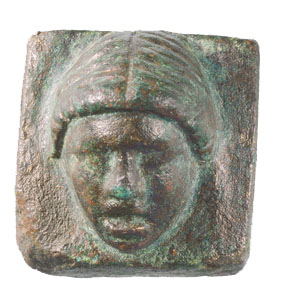
-
Copyright credit: J. Paul Getty Museum

ARCHAEOLOGICAL DESCRIPTION OF THE WEIGHT
Authority
Mint
Denomination
Material
Copper alloy (bronze or brass)
Manufacture
Cast
Shape
Cube or cuboid
Length
1.59 cm
(0.625 inch)
Width
1.43 cm
(0.5625 inch)
Height
1.43 cm
(0.5625 inch)
Metrology
| Mass (g) | Mass (grain) | Date of measurement | Reference | fragmented | cleaned | reference weight |
|---|---|---|---|---|---|---|
| 235.01 | 3626.7004797303 | - | www.getty.edu | No | No | Yes |
Iconography
| Symbol | Technique | Direction | Position | Number | Synecdoche |
|---|---|---|---|---|---|
| Mask |
Wear
Corrosion
Handle
No
Suspension hole
No
Recarved mould
No
Recarved weight
No
Intentionally destroyed
No
Archaeological description
Getty Museum: A theatrical mask emerges from the surface of this thick bronze plaque. The theater was immensely popular in the Greek and Roman world and this interest in theater found expression in the numerous theatrical motifs used for decorative purposes, from lamps to wall-paintings. Sometimes actors were portrayed, and other times, as here, a theatrical mask stood alone. The type of mask shown on this weight with a smooth youthful face, down-turned mouth, and plain center-parted hair originated in the Hellenistic period and continued into Roman times. Used with a simple pan balance, this plaque was probably a shop or market weight. Scholars are unsure as to the date of this weight. The high relief and detailed rendering of the mask suggest that it dates to the second or first centuries B.C. The weight of the piece, however, suggests a Roman date, since it weighs the same as six [actually: sixty] silver denarii, Roman coins, in the Julio-Claudian period. This correlation of weight is probably deliberate.
Autopsy
No
INSCRIPTION
| Language | Technique | Legend type |
|---|
Fac simile
Edition
Monogram
ARCHAEOLOGICAL CONTEXT
Findspot (region)
Findspot (site)
context
CIRCUMSTANCES OF ACQUISITION
Region
City
Date of first acquisition
circumstances
Gift of Barbara and Lawrence Fleischman (New York, 1925 - New York, 1997) to the J. Paul Getty Museum in 1996. Gift of Robin Symes and Christo Michailides (London, England) to Barbara Fleischman in 1990.
DATING OF THE WEIGHT
Curatorial Section
GREEK
,
ROMAN
Time frame
Comments on Chronology
1st century B.C. - 1st century A.D.
COLLECTION HISTORY
Collection
| Name | Date of acquisition | Inventory number |
|---|---|---|
| Fleischman Collection | Jan. 1, 1990 | F213 |
| Getty Museum – Getty Villa (Malibu) | Jan. 1, 1996 | 96.AC.147 |
| Symes Collection | None |
Bibliography
| Reference | Page/Column | Reference (number) | Plate / Figure | Comment |
|---|---|---|---|---|
| True and Hamma 1994 | 205 | 99 | ||
| Getty Museum 1997–98 | 65 |
VARIA
Additional comment
Greek or Roman weight, Italy (?).
Permalink